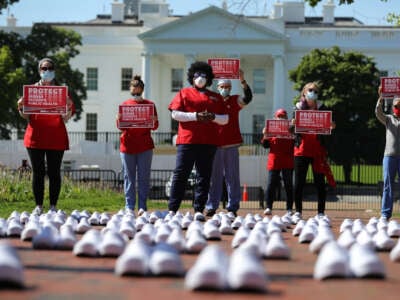Over the last couple of weeks, even as tariffs have wreaked havoc on markets around the world, President Donald Trump and U.S. Commerce Secretary Howard Lutnick have repeatedly teased the notion of slapping hefty tariffs on imported pharmaceuticals. Lutnick has said these are likely to be introduced before the summer.
Trump’s rationale for placing tariffs on medical drugs is, like most of his other major policy initiatives, framed around national security: It makes no sense, he says, to be reliant on other countries for supplies of medicines.
Certainly, in the long run, it would be a good thing for the U.S. to have the capacity to make more of its own medicines, not least so that in a pandemic, when supply chains break down, people can still access medications stateside. However, whatever the merits of that argument, Trump’s plan will make a bad situation worse. One can’t simply will the infrastructure and supply chains for the production of large amounts of medicines into existence overnight. The U.S. has a good base for manufacturing branded medicines — those under patents — but generic drugs are overwhelmingly produced overseas. Last year, according to the United Nations trade database, the U.S. imported a whopping $213 billion worth of pharmaceutical products.
In reality, if Trump slaps tariffs on pharmaceuticals made in India and other global hubs for medicine manufacturing, patients in the U.S. will have to pay more for their generic medications. Or manufacturers will simply choose to export their drugs elsewhere, resulting in shortages of medicines; that’s what has happened in post-Brexit Britain, where at times even basic drugs have been in short supply in recent years, and where growth in medication imports has been lower than for any other G7 nation.
Since many insurance formularies either don’t cover the non-generic patented drugs made in the U.S. or charge patients huge co-pays for these medications, even if the supply could be ramped up to cancel out the hit to generics, the price tags would likely be unaffordable for tens of millions of people.
The teasing of soon-to-be-introduced tariffs comes on top of an April 15 executive order that Trump framed as lowering drug prices for Americans, but which in reality is a giveaway to Big Pharma. The order extends the time frame in which pill-based medications are excluded from price negotiations with Medicare — and, by extension, increases the time that the manufacturers can charge exorbitantly high rates for their patented products.
If Trump slaps tariffs on pharmaceuticals made in India and other global hubs for medicine manufacturing, patients in the U.S. will have to pay more for their generic medications.
Trump, along with Health and Human Services (HHS) Secretary Robert F. Kennedy Jr. and the administration’s congressional supporters, have disingenuously talked about “Making America Healthy Again.” However, the tariffs are part of a vastly destructive machinery putting downward pressure on Americans’ health that now encompasses virtually all parts of life in the U.S.
This week, multiple news outlets reported that the Food and Drug Administration — a staple of the modern state since Theodore Roosevelt’s presidency shortly after the turn of the last century — was seeking to end most of its routine inspections, handing off this critical function to the states. Given that many state public health and inspection systems are in shambles, and that the U.S. food supply is so complex that supermarket produce might contain ingredients from multiple states, this has the potential to dramatically increase the risk of everything from salmonella and E. coli outbreaks through to contamination of the food supply from toxic metals, plastics and chemicals.
In early April, thousands of HHS employees were fired. Staffing numbers at the Centers for Disease Control and Prevention and the National Institutes of Health have been massively reduced. Specialty units working on everything from drug-resistant STIs to HIV transmission among vulnerable youth, to controlling tuberculosis outbreaks and understanding the transmission pathways of viral hepatitis have been destroyed. Organizations working on environmental justice and health care disparities have been defunded in the Trump administration’s war on “DEI.” Violence prevention programs have been eliminated. Almost all of the staff at the National Institute for Occupational Safety and Health have been notified that they will likely soon be fired as part of so-called “reductions in force.” There have been enormous cuts to the staff of the National Center for Chronic Disease Prevention and Health Promotion.
The methods of assault on health care access and research are multifaceted. University science funding is under an unprecedented attack. USAID — which has been vital in controlling potential pandemics, such as Ebola, at the source before they spread to the rest of the world, as well as in testing new vaccines and medications — has been eliminated.
Meanwhile, the Trump administration made the startling decision to replace the entirety of scientific and medical advice about COVID-19 (and what to do if you contract the disease) on its White House COVID webpage with a speculative essay announcing that the pandemic was the result of a lab leak in China. In bold letters it proclaims “LAB LEAK” and has a photo of a larger-than-life Trump striding toward the viewer. It’s hard to look at this strange image without thinking of the grand masters of propaganda from totalitarian regimes of the past.
In March, HHS cancelled $12 billion in public health grants to the states, thus in a single blow decapitating many programs to track infectious diseases, to provide mental health services to vulnerable residents and to expand addiction treatment programs.
Moreover, CNN obtained a document suggesting that the administration wants to reduce the entirety of the federal health budget by a third, which would eliminate roughly $40 billion in services.
Around the country, as federal funding has dried up, vaccination clinics have been scrapped. It’s very likely that many of our peer nations around the world will start issuing public health advisories about the risks of traveling to the United States. Children, in particular, will now fall through these gaping public health cracks — and, if the current measles epidemic is an indicator of things to come, many will get sick and some will die. Meanwhile, if Trump’s plans to entirely defund Head Start are implemented, millions of low-income youth will have less access to education, to free breakfasts and to the opportunity that early education generates. That, too, will have a huge, multi-generational, long-term health impact.
Many of these cuts are currently being challenged in the courts, and not all of them will ultimately be fully realized. But on a daily basis, the damage is already being done. A public health infrastructure and regulatory system carefully built up over more than a century is being speedily demolished. Add all of this up and one thing is clear: At every level, the U.S. is being made less healthy and the country’s ability to fight disease outbreaks is being eviscerated. It’s hardly rocket science to conclude that this neither “makes America great again” nor makes it “healthy again.”
So, back to tariffs. Should we be surprised that Trump seems hell-bent on implementing a policy that will make it even harder for already cash-strapped Americans to find affordable medications? Of course not. For the last three months, even as he wraps himself in the U.S. flag, Trump has rolled out policies seemingly on an hourly basis that, by any objective measure, are detrimental to the U.S.’s well-being. It’s hard to see how, taken as a whole, this is anything other than a deliberate wrecking-ball effort designed to make the U.S. as unhealthy as possible and vulnerable to emergent diseases.
Despite Trump’s insistence that these measures are meant to strengthen the United States against supposed foreign adversaries, in a few short months his administration appears to have done more to threaten the health and safety of the nation’s residents than any adversary could dream of.
Angry, shocked, overwhelmed? Take action: Support independent media.
We’ve borne witness to a chaotic first few months in Trump’s presidency.
Over the last months, each executive order has delivered shock and bewilderment — a core part of a strategy to make the right-wing turn feel inevitable and overwhelming. But, as organizer Sandra Avalos implored us to remember in Truthout last November, “Together, we are more powerful than Trump.”
Indeed, the Trump administration is pushing through executive orders, but — as we’ve reported at Truthout — many are in legal limbo and face court challenges from unions and civil rights groups. Efforts to quash anti-racist teaching and DEI programs are stalled by education faculty, staff, and students refusing to comply. And communities across the country are coming together to raise the alarm on ICE raids, inform neighbors of their civil rights, and protect each other in moving shows of solidarity.
It will be a long fight ahead. And as nonprofit movement media, Truthout plans to be there documenting and uplifting resistance.
As we undertake this life-sustaining work, we appeal for your support. Please, if you find value in what we do, join our community of sustainers by making a monthly or one-time gift.
Read full article at source
Stay informed about this story by subscribing to our regular Newsletter


